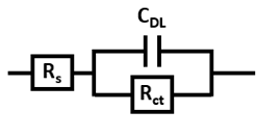To correct for ohmic losses from the potential drop across the electrolyte due to the distance between the electrodes, electrochemical impedance spectroscopy (EIS) is typically employed to measure this electrolyte resistance (R_s).
Currently I think that the Nyquist plot (where each point has a frequency and a real and imaginary impedance) needs to be fitted to an equivalent Randles circuit, which then allows determination of the R_s. The one in particular should be 
What I'm hoping to achieve is something like this, as well as to finding the solution resistance to calculate iR drop:

How could this be done? Here is an example of the data I have:
| freq in Hz | Re(Z) in Ohm | -Im(Z) in Ohm |
|---|---|---|
| 1.0000371E+005 | 1.2838266E+000 | -4.7236100E-001 |
| 6.7491828E+004 | 1.2575362E+000 | -2.9951397E-001 |
| 4.5557453E+004 | 1.2489935E+000 | -1.9674678E-001 |
| 3.0748963E+004 | 1.2461497E+000 | -1.3021792E-001 |
| 2.0756010E+004 | 1.2463084E+000 | -8.5121296E-002 |
| 1.4010540E+004 | 1.2458339E+000 | -5.3675517E-002 |
| 9.4523906E+003 | 1.2463924E+000 | -3.2538280E-002 |
| 6.3779312E+003 | 1.2452079E+000 | -2.0627080E-002 |
| 4.3063779E+003 | 1.2464187E+000 | -7.8994250E-003 |
| 2.9059297E+003 | 1.2512513E+000 | -7.8682322E-004 |
| 1.9631409E+003 | 1.2515490E+000 | 5.4816552E-003 |
| 1.3237295E+003 | 1.2460785E+000 | 5.2928450E-003 |
| 8.9414160E+002 | 1.2562760E+000 | 1.8789139E-002 |
| 6.0287787E+002 | 1.2608212E+000 | 2.7019683E-002 |
| 4.0721527E+002 | 1.2652799E+000 | 3.7225980E-002 |
| 2.7473624E+002 | 1.2735685E+000 | 4.8571289E-002 |
| 1.8553433E+002 | 1.2811457E+000 | 6.3650906E-002 |
| 1.2520035E+002 | 1.2927077E+000 | 8.0610186E-002 |
| 8.4486298E+001 | 1.3058180E+000 | 9.9876016E-002 |
| 5.7063412E+001 | 1.3209573E+000 | 1.3237002E-001 |
| 3.8485222E+001 | 1.3433586E+000 | 1.6853021E-001 |
| 2.5972410E+001 | 1.3701465E+000 | 2.2286178E-001 |
| 1.7516815E+001 | 1.4067172E+000 | 2.9568654E-001 |
| 1.1837119E+001 | 1.4666675E+000 | 3.9322603E-001 |
| 7.9882402E+000 | 1.5431337E+000 | 5.2406406E-001 |
| 5.3879313E+000 | 1.6745517E+000 | 6.8878186E-001 |
| 3.6371040E+000 | 1.8626976E+000 | 8.5898042E-001 |
| 2.4567609E+000 | 2.1712506E+000 | 1.0030348E+000 |
| 1.6587046E+000 | 2.5552261E+000 | 1.0842789E+000 |
| 1.1199110E+000 | 2.9400694E+000 | 1.0472580E+000 |
| 7.5526887E-001 | 3.2742524E+000 | 8.9296573E-001 |
| 5.0942224E-001 | 3.5140378E+000 | 7.0039696E-001 |
| 3.4379947E-001 | 3.6070650E+000 | 5.1860118E-001 |
| 2.3239036E-001 | 3.6902442E+000 | 3.5689598E-001 |
| 1.5689009E-001 | 3.7351005E+000 | 2.2994351E-001 |
| 1.0589487E-001 | 3.7651119E+000 | 1.3973090E-001 |
| 7.1417451E-002 | 3.7816873E+000 | 3.9920006E-002 |
| 4.8211023E-002 | 3.7677062E+000 | -8.1531301E-002 |
| 3.2556150E-002 | 3.7300577E+000 | -1.7607281E-001 |
| 2.1934874E-002 | 3.6879458E+000 | -1.6583309E-001 |
| 1.4821894E-002 | 3.6872365E+000 | -1.9536464E-001 |
| 1.0009173E-002 | 3.6411600E+000 | -1.3885058E-001 |

